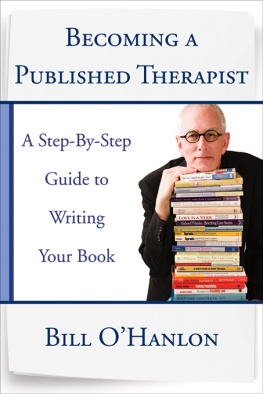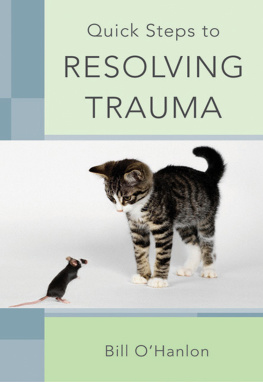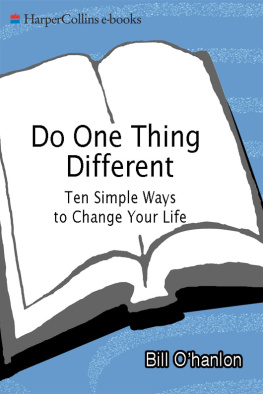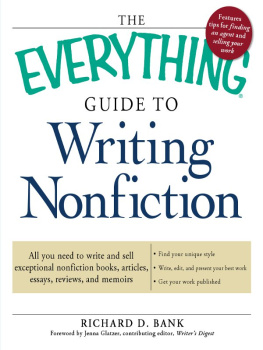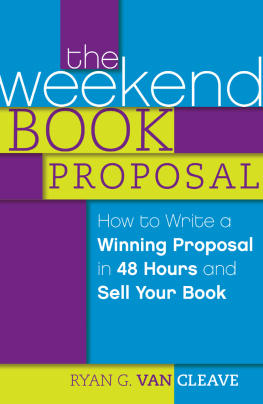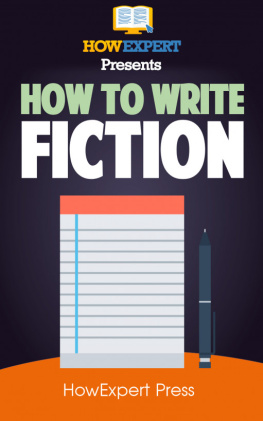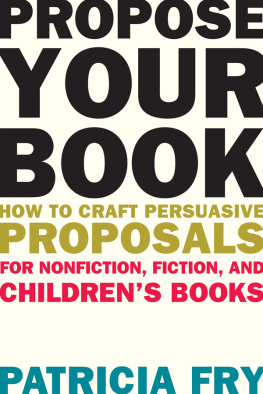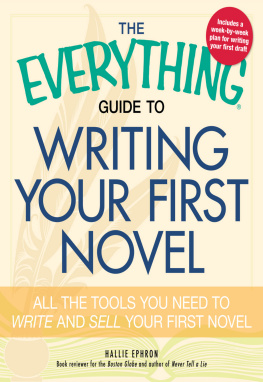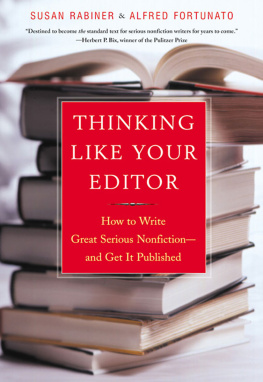
Becoming a Published Therapist
A Step-by-Step Guide to Writing Your Book

Bill OHanlon

To Helen, who has written something deep on my heart.
Contents

I GOT THE CALL TO WRITE A BOOK SOME YEARS AGO. I had been presenting workshops for the previous seven years, and participants in my workshops had regularly begun to ask, Where is your book?
I would tell them I wasnt a writer. I had never had ambitions to write, although I loved to read. I didnt have much patience for sitting down and writing; I would rather speak. Also, I had no clue how to write a book or how to get it published.
Fast-forward 24 years. I have now written and published more than 30 books, many of them by mainstream firms such as W. W. Norton, the publisher of this book. One of my books got me on Oprah . My books have sold hundreds of thousands of copies all over the world. They have been translated into 16 languages.
How did I get from clueless to clued-in? How do you go from I dont know how to write to Stop me before I write again?
Thats where you come in. You are probably reading this book because you have some curiosity about book writing and publishing or you wish to write a book and get it published. And because I wasnt a natural writer and was clueless about the process of both writing and publishing, I think I may be the perfect guide for you in realizing your writing dreams and goals.
I went to a brown-bag lunchtime presentation at a large psychotherapy conference some years ago, and the well-known presenter was giving a session on how to get a book published. She began by saying that an agent had learned of her work, approached her, and suggested she write a book. The book quickly became a best-seller. She admitted she really didnt know that much about getting an agent and getting published and that she had essentially fallen into best-sellerdom.
That certainly isnt my story. I worked at it by struggling to learn how to write and complete a book and then get it published. I think my journey is typical for most authors; in many ways, its a hopeful message I have for you. Even if you are not a natural writer, even if you have no idea how to get a book published, its possible to do both. Ill tell you exactly how to do so.
There are several components to the successful therapist/writer path:
1. Managing to find the time and discipline to write amid a busy life and practice;
2. Finding your writing style and voice;
3. Finding the intersection for your expertise, your passion, and the needs of the marketplace; and
4. Learning about and handling the business and marketing aspects of publishing in order to ensure that your book finds its intended readers.
If you are willing to engage in and accomplish each of these goals, the odds of getting your book written and published will increase.
I began to write in 1982. I was asked to be a guest editor for a journal issue, and, because I knew the editor wouldnt turn me down, I decided to write two articles for that issue. I wrote them on an electric typewriter (that should carbon-date me). It was very hard to write those articles: I avoided sitting at the typewriter; I was nervous and unconfident. When I finally began to write, I found my words to be flat and not at all reflective of what was in my mind or my heart.
I had to revise those first two articles again and again and still I didnt think they were well written. But they were good enough to publish in a clinical journal. (I actually met someone years later who told me they were his favorite articles in the issue, but they werent my favorites, I can assure you.) That seemed to get me over the hump. I had become a published author!
This leads us to Lesson #1: Start writing and do what you can do to get anything published. This will help you think of yourself as a writer, thereby breaking that initial psychological barrier of not having been published. It will also help you begin to establish your writing platform (more on that later).
At a family therapy conference I attended, I met an acquiring editor, Susan Barrows, who ended up offering me a contract for my first book for W. W. Norton. In our initial discussion, I told her I was planning to write a book about Milton Ericksons work someday. She told me to keep her in mind when I did.
Lesson #2: Relationships, like in any endeavor, can help. People tend to think of the publishing industry in abstract terms, but for me it has mostly been about relationships with people. My current editor at W. W. Norton, Deborah Malmud, and I have an easy and good relationship that actually led to this book being written. Like with any relationship, if you are disagreeable, dont keep your word, or are demanding or entitled, dont expect to get far. Likewise, if an editor or agent in the publishing industry treats you badly or doesnt keep his or her word, ease out of that relationship as gracefully as you can.
I found the idea of writing a whole book quite daunting, so when a colleague in England (Jim Wilk) suggested we write a book together, I jumped at the chance, figuring that having a partner would be half the work. We got a contract offer from Guilford Press, a publisher that specialized in books for psychotherapists. I actually wrote many of my initial books with coauthors. Writing can be a lonely endeavor, and I find I keep my word to others better than if I make myself a promise to write or finish something by a certain time.
Lesson #3: Find a partner to write with if you find the task too daunting. Obviously, find someone who can pull his or her weight and who is able to work collaboratively.
It turned out that, due to Jim being in England (in the days before computers, email, and the Internet) and due to some personnel changes at Guilford, that first book, which was begun in 1983, didnt actually appear in print until 1987. By then, a book that I had done for W. W. Norton had been published.
Jim and I rewrote that book for Guilford 38 times! Because it was a first book for both of us, we wanted to get it right. Also, as I mentioned, I wasnt a very good writer and most of my final writing turned out to be rewriting. It took us the better part of three years to finish composing that book and then almost another year for it to be published.
Lesson #4: Traditional print publishing can take years. Be patient. Also, Lesson #5: Most good writing is the result of rewriting.
Eventually, I began to be faster and better at the book-writing process. After those first titles, each book generally took a year to write and rewrite. Later still, after many more publications, I found my writing and rewriting time was reduced to about three months per book.
After more than 30 books now, I usually write a book in a matter of weeks rather than in months or years. So I went from being a tortured, slow, not natural, or good writer to being a fast and relatively good writer. (I can always improve, and I still work on my writing skill regularly.)
Lesson #6: You will get better with more experience and practice.
One more note: This book is mostly about writing and publishing nonfiction, because thats what most therapists aim to do and that is also what I have experience and expertise in. Some of the material in the book also applies to writing and publishing fiction and will help in that endeavor, but fiction is a whole different kettle of fish and beyond the main scope of this book.
Next page
